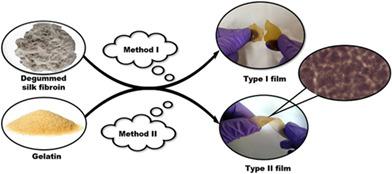当前位置:
X-MOL 学术
›
Polym. Int.
›
论文详情
Our official English website, www.x-mol.net, welcomes your
feedback! (Note: you will need to create a separate account there.)
Deduction of a facile method to construct Antheraea mylitta silk fibroin/gelatin blend films for prospective biomedical applications
Polymer International ( IF 2.9 ) Pub Date : 2020-07-13 , DOI: 10.1002/pi.6087 Radhika Batra 1 , Roli Purwar 1
Polymer International ( IF 2.9 ) Pub Date : 2020-07-13 , DOI: 10.1002/pi.6087 Radhika Batra 1 , Roli Purwar 1
Affiliation

|
Blend films of two types (I and II) were prepared by mixing Antheraea mylitta silk fibroin (AMF) and gelatin solution in various blend ratios via the solution casting method. Two different crosslinkers, namely glutaraldehyde and genipin, were used during blend preparation. The structural characteristics and thermal properties of the blend films were examined by Fourier transform infrared (FTIR) spectroscopy, X‐ray diffraction (XRD), Thermogravimetric analysis (TGA) and Diffrential scanning calorimetery (DSC). The FTIR spectra showed conformational alterations in type I blend films while type II films attained high β‐sheet crystallinity. The XRD diffractograms presented a high degree of crystallinity in type II blend films compared to type I, which showed an almost amorphous structure. Further, thermal and biological studies were conducted on type II films. According to the TGA thermograms, the degradation temperature of the crosslinked blend films shifted compared to pure gelatin and pure AMF films. Partial miscibility of the two components was indicated by DSC thermograms of the blends. The high water uptake capacity of type II blend films was found to imitate hydrogel behaviour. The blend films did not show any toxicity in 3‐(4,5‐dimethylthiazol‐2‐yl)‐2,5‐diphenyl tetrazolium bromide (MTT) assay and supported L929 fibroblast cell spreading and proliferation. The biodegradation of the blend films was significantly faster than the pure silk film. © 2020 Society of Industrial Chemistry
中文翻译:

推论构建可用于未来生物医学应用的my蚕丝丝蛋白/明胶共混膜的简便方法
通过混合my鱼(Antheraea mylitta)制备两种类型(I和II)的共混膜通过溶液流延法以各种混合比例混合丝素蛋白(AMF)和明胶溶液。在共混物制备过程中使用了两种不同的交联剂,即戊二醛和genipin。通过傅立叶变换红外(FTIR)光谱,X射线衍射(XRD),热重分析(TGA)和差示扫描量热法(DSC)检查了共混膜的结构特征和热性能。FTIR光谱显示I型混合膜的构象变化,而II型膜则具有高的β片结晶度。与I型混合膜相比,XRD衍射图显示II型混合膜具有很高的结晶度,而I型混合膜则显示出几乎无定形的结构。此外,对II型膜进行了热和生物学研究。根据TGA热分析图,与纯明胶和纯AMF膜相比,交联共混物膜的降解温度发生了变化。通过共混物的DSC热分析图表明了两种组分的部分混溶性。发现II型共混物膜的高吸水能力可模仿水凝胶行为。共混膜在3-(4,5-二甲基噻唑-2-基)-2-,5-二苯基溴化四氮唑(MTT)分析中未显示任何毒性,并支持L929成纤维细胞的扩散和增殖。混合膜的生物降解明显快于纯丝膜。©2020工业化学学会 发现II型共混物膜的高吸水能力可模仿水凝胶行为。共混膜在3-(4,5-二甲基噻唑-2-基)-2-,5-二苯基溴化四氮唑(MTT)分析中未显示任何毒性,并支持L929成纤维细胞的扩散和增殖。混合膜的生物降解明显快于纯丝膜。©2020工业化学学会 发现II型共混物膜的高吸水能力模仿水凝胶行为。共混膜在3-(4,5-二甲基噻唑-2-基)-2-,5-二苯基溴化四氮唑(MTT)分析中未显示任何毒性,并支持L929成纤维细胞的扩散和增殖。混合膜的生物降解明显快于纯丝膜。©2020工业化学学会
更新日期:2020-07-13
中文翻译:

推论构建可用于未来生物医学应用的my蚕丝丝蛋白/明胶共混膜的简便方法
通过混合my鱼(Antheraea mylitta)制备两种类型(I和II)的共混膜通过溶液流延法以各种混合比例混合丝素蛋白(AMF)和明胶溶液。在共混物制备过程中使用了两种不同的交联剂,即戊二醛和genipin。通过傅立叶变换红外(FTIR)光谱,X射线衍射(XRD),热重分析(TGA)和差示扫描量热法(DSC)检查了共混膜的结构特征和热性能。FTIR光谱显示I型混合膜的构象变化,而II型膜则具有高的β片结晶度。与I型混合膜相比,XRD衍射图显示II型混合膜具有很高的结晶度,而I型混合膜则显示出几乎无定形的结构。此外,对II型膜进行了热和生物学研究。根据TGA热分析图,与纯明胶和纯AMF膜相比,交联共混物膜的降解温度发生了变化。通过共混物的DSC热分析图表明了两种组分的部分混溶性。发现II型共混物膜的高吸水能力可模仿水凝胶行为。共混膜在3-(4,5-二甲基噻唑-2-基)-2-,5-二苯基溴化四氮唑(MTT)分析中未显示任何毒性,并支持L929成纤维细胞的扩散和增殖。混合膜的生物降解明显快于纯丝膜。©2020工业化学学会 发现II型共混物膜的高吸水能力可模仿水凝胶行为。共混膜在3-(4,5-二甲基噻唑-2-基)-2-,5-二苯基溴化四氮唑(MTT)分析中未显示任何毒性,并支持L929成纤维细胞的扩散和增殖。混合膜的生物降解明显快于纯丝膜。©2020工业化学学会 发现II型共混物膜的高吸水能力模仿水凝胶行为。共混膜在3-(4,5-二甲基噻唑-2-基)-2-,5-二苯基溴化四氮唑(MTT)分析中未显示任何毒性,并支持L929成纤维细胞的扩散和增殖。混合膜的生物降解明显快于纯丝膜。©2020工业化学学会











































 京公网安备 11010802027423号
京公网安备 11010802027423号